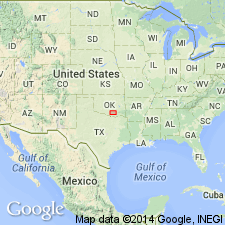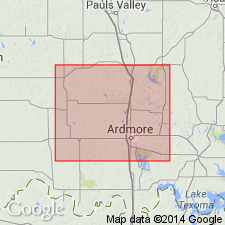
- Usage in publication:
-
- Colbert porphyry
- Modifications:
-
- Areal extent
- AAPG geologic province:
-
- South Oklahoma folded belt
- Midcontinent region
Summary:
Pg. 470-474, map. Colbert porphyry. Pink porphyry dikes of pre-Cambrian age.
[Origin of name not stated. Occurs in Arbuckle Mountains, central southern OK.]
Source: US geologic names lexicon (USGS Bull. 896, p. 484).

- Usage in publication:
-
- Colbert porphyry
- Modifications:
-
- Areal extent
- AAPG geologic province:
-
- South Oklahoma folded belt
- Midcontinent region
Summary:
Pg. 9-10. Colbert porphyry. A mass rising in East Timbered Hills to highest point in Arbuckle Mountains, central southern Oklahoma, 1,400+/- feet altitude. Is largely pink feldspar phenocrysts in a reddish to gray groundmass, cut by numerous diabase dikes. Probably formed at less depth than Tishomingo granite. Lack of metamorphism in Colbert porphyry and Tishomingo granite suggests they are not older than Algonkian; may be as recent as Keweenawan or even Cambrian.
[Origin of name not stated.]
Source: US geologic names lexicon (USGS Bull. 896, p. 484).
For more information, please contact Nancy Stamm, Geologic Names Committee Secretary.
Asterisk (*) indicates published by U.S. Geological Survey authors.
"No current usage" (†) implies that a name has been abandoned or has fallen into disuse. Former usage and, if known, replacement name given in parentheses ( ).
Slash (/) indicates name conflicts with nomenclatural guidelines (CSN, 1933; ACSN, 1961, 1970; NACSN, 1983, 2005, 2021). May be explained within brackets ([ ]).

